Post by Tharon on Apr 25, 2009 10:04:59 GMT -5
Base Races

Human
Humans were the galaxy's most numerous and politically dominant sentient species with millions of major and minor colonies galaxywide. Believed to have originated on the galactic capital of Coruscant, they could be found anywhere, engaged in many different pursuits: spacers, mercenaries, smugglers, merchants, soldiers, assassins, farmers, crime lords, laborers, slaves, slavers, and many others, including Jedi. Since Humans were the most common sentient species, they were often considered to be a standard or average to which the biology, psychology, and culture of other species were compared.

Bothan
Bothans were furry mammalian anthropoids, about 1.5 meters tall. Hailing from Bothawui and several colonies, Bothans differed in facial appearance and body structure with canine, feline, and equine features. They were known for being master politicians and spies, craving intrigue and subterfuge
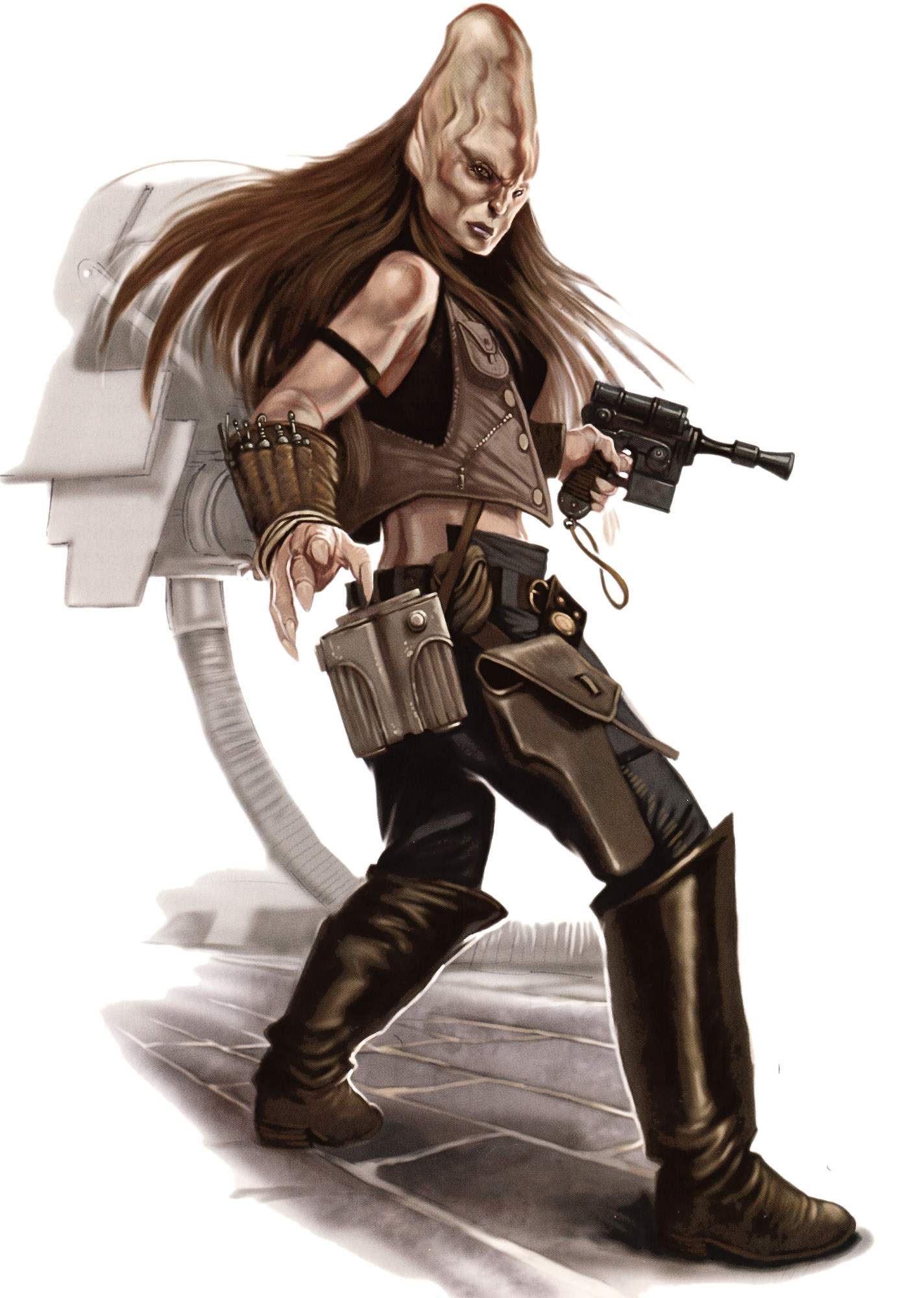
Cerean
Cereans were a sophisticated and cultured humanoid mammalian species that hailed from the planet Cerea in the Mid Rim. They had tall tapering heads, which housed large binary brains, enabling them to focus on many things at the same time. Aside from this unique feature, Cereans were physically similar to Humans, although they possessed an extra heart, which supplied extra blood circulation to support their brains. Cerean males aged more quickly than the females, who had similar lifespans to Humans. Thus, there were fewer males than females. Polygamous marriage was a necessity in order for the species to survive. Each male usually had one primary "bond-wife", and between four and ten "honor-wives". Famous for their extraordinary thinking abilities, Cereans were often found among the ranks of the Jedi Knights, being exempt from the Jedi's vow of celibacy, due to their low birth rates. One such Jedi, Ki-Adi-Mundi, served the Jedi High Council during and prior to the outbreak of the Clone Wars.
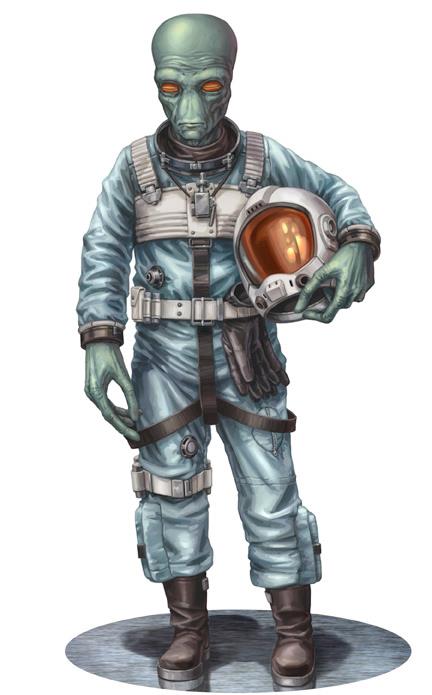
Duros
The Duros, sometimes known as Durosians, were a humanoid species native to the planet Duro who were among the galaxy's first space faring races.Their homeworld was located on both the Corellian Trade Spine and at the end of the Duros Space Run, two major hyperspace routes that linked Duro with other important commercial centers. The Duros were humanoids with smooth blue-green skin, red eyes, lipless mouths, and long thin noseless faces. Olfactory glands beneath their eyes were responsible for their sense of smell. Both females and males were bald, though both genders were easily distinguished. Their large red goggle-like eyes also had slit pupils. Duros females gave birth to live young.
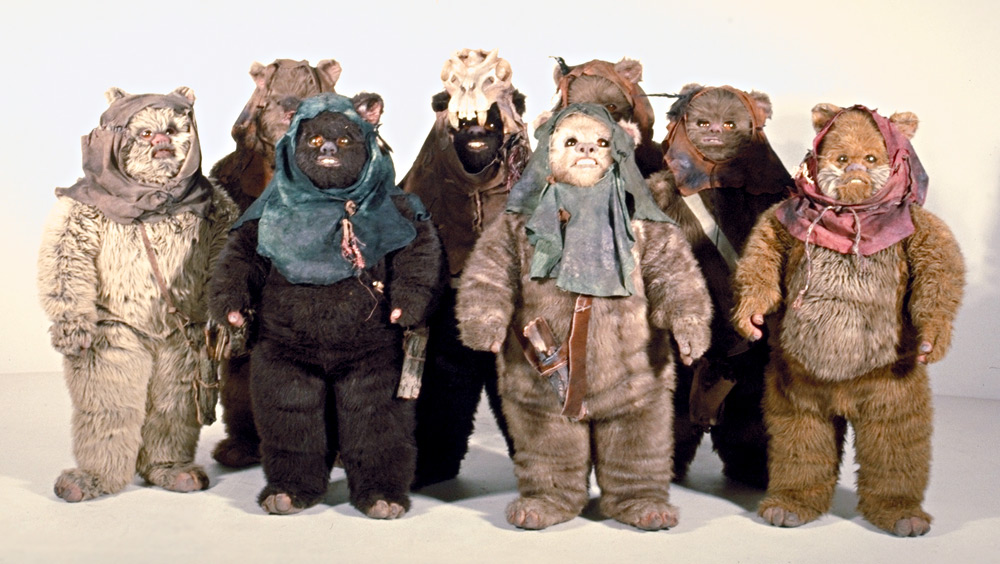
Ewok
Ewoks were sentient diminutive furry bipeds native to the forest moon of Endor. They were most notable for helping the Rebel Alliance defeat the forces of the Galactic Empire at the Battle of Endor, allowing the shield generator there to be destroyed, and in turn, the second Death Star. Ewoks were curious individuals that stood about one meter tall; they were omnivorous and used spears, slings, and knives as weapons; they also used hang gliders, battle wagons, and bordoks as vehicles. Although extremely skilled in forest survival and the construction of primitive technology like gliders and catapults, the Ewoks had yet to progress past stone-level technology when discovered by the Empire. They were quick learners, however, when exposed to advanced technology with simple mechanical processes and concepts. Some Ewoks were removed from their planet and taken as pets or slaves. Others left voluntarily out of a sense of curiosity, especially after the Battle of Endor led to the establishment of New Republic trading posts on the Forest Moon.

Gamorrean
Gamorreans were typically green-skinned with a large powerful physique, and were known to be fierce warriors prized for their great strength and brutality in combat. They were organized into clans headed by a Council of Matrons. In Gamorrean society female sows perform all the productive work while the male boars concentrated on training for and fighting wars.

Gungan
The Gungans were humanoids native to the planet of Naboo. Prior to the Invasion of Naboo, the Gungans were a largely isolationist society. The Gungans were able to combine machinery with biology. Individuals were called a Gung.
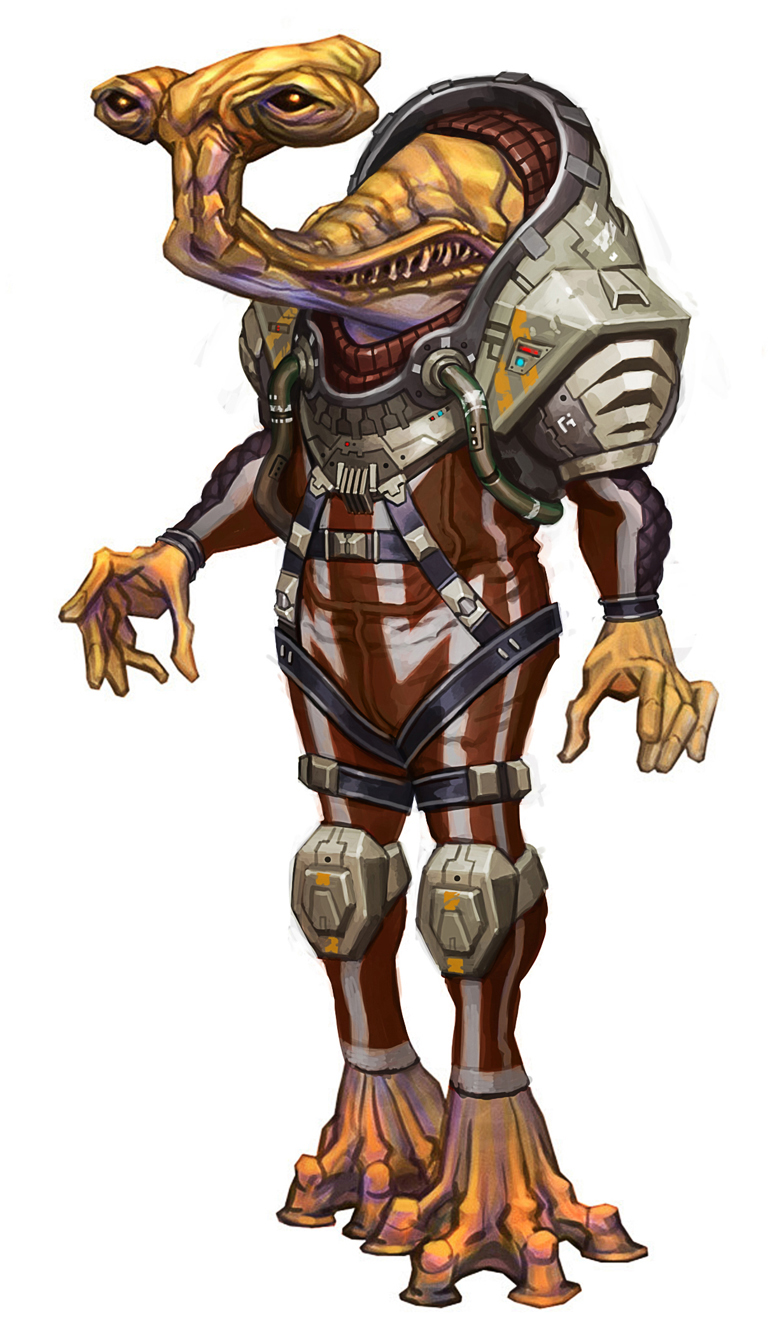
Ithorian
Ithorians had two mouths and four throats, allowing them to speak in stereo. Female Ithorians had two humps on the back of their head, while males had only one. They had glossy, usually brown flesh. They stood roughly between 1.8 to 2.3 meters (5ft 10in. to 7ft 6in.) from eyestalk to toe. Their reflexes and coordination were somewhat slower than that of average humanoids.In addition to allowing them to speak their unique stereophonic language, the Ithorians' four throats had the ability to violently expel air, resulting in a deafening and concussive scream. Although even common Ithorians possessed this strange talent (which was possibly a leftover evolutionary defense mechanism), those with Force training (such as Jedi Master Roron Corobb) could push enough power into their sonic bellow to shatter iron and shred plasteel. Even so, many would go their entire lives without resorting to this physically taxing ability, and so its existence remained relatively ambiguous.
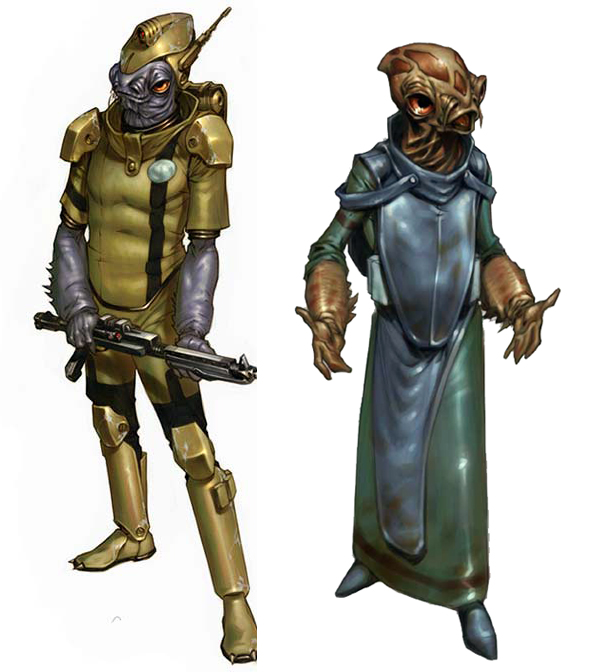
Mon Calamari
Mon Calamari were fish-like amphibious humanoids with domed heads, webbed hands, and large eyes. Male Mon Calamari had protrusions on their chin called "barbels" which grew more numerous with age. Most Mon Calamari had salmon-colored skin, often mottled with light and dark patterns, though examples of other skin colors were known. They could also descend to depths of up to 30 meters below sea level without breathing, though they found it uncomfortable and often used organic gills. Mon Calamari could stay underwater for a long period of time. Their hands, apart from being webbed, also featured five claw-tipped fingers; one opposable thumb with two more shorter claw-like protrusions, two long middle fingers, and two extremely short outer fingers. As an additional feature, Mon Calamari hands also presented three suction-cup like holes on their palms.Mon Calamari could swivel their eyes independently from one another, focusing on two areas at once. Mon Calamari saw in different wavelengths than Humans, making it difficult for one species to view visuals designed for the other and vice versa. Their eyes were often used to express emotion; staring with the left eye was a way of showing surprise, while staring with the right eye was either a challenge to fight or an expression of love, depending on the circumstances.
- can never drown
- 2x human swim speed
- can not see holograms meant for humans (they need special versions)

Rodian
The Rodians were green-skinned humanoids from the planet Rodia. They possessed distinctive faces; large, round, multifaceted eyes, tapir-like snouts, and a pair of saucer-shaped antennae on their heads. Rodian skin normally had a rough, pebbly texture, except on their hands and snouts. The flexible snouts augmented the Rodians finely-tuned olfactory senses, collecting and filtering the air. Their characteristically-large eyes were indicative of a primarily-nocturnal ancestry and were capable of seeing into the infra-red spectrum. This allowed the Rodians to visually detect the body heat of their hidden prey emanating from within the darkness.
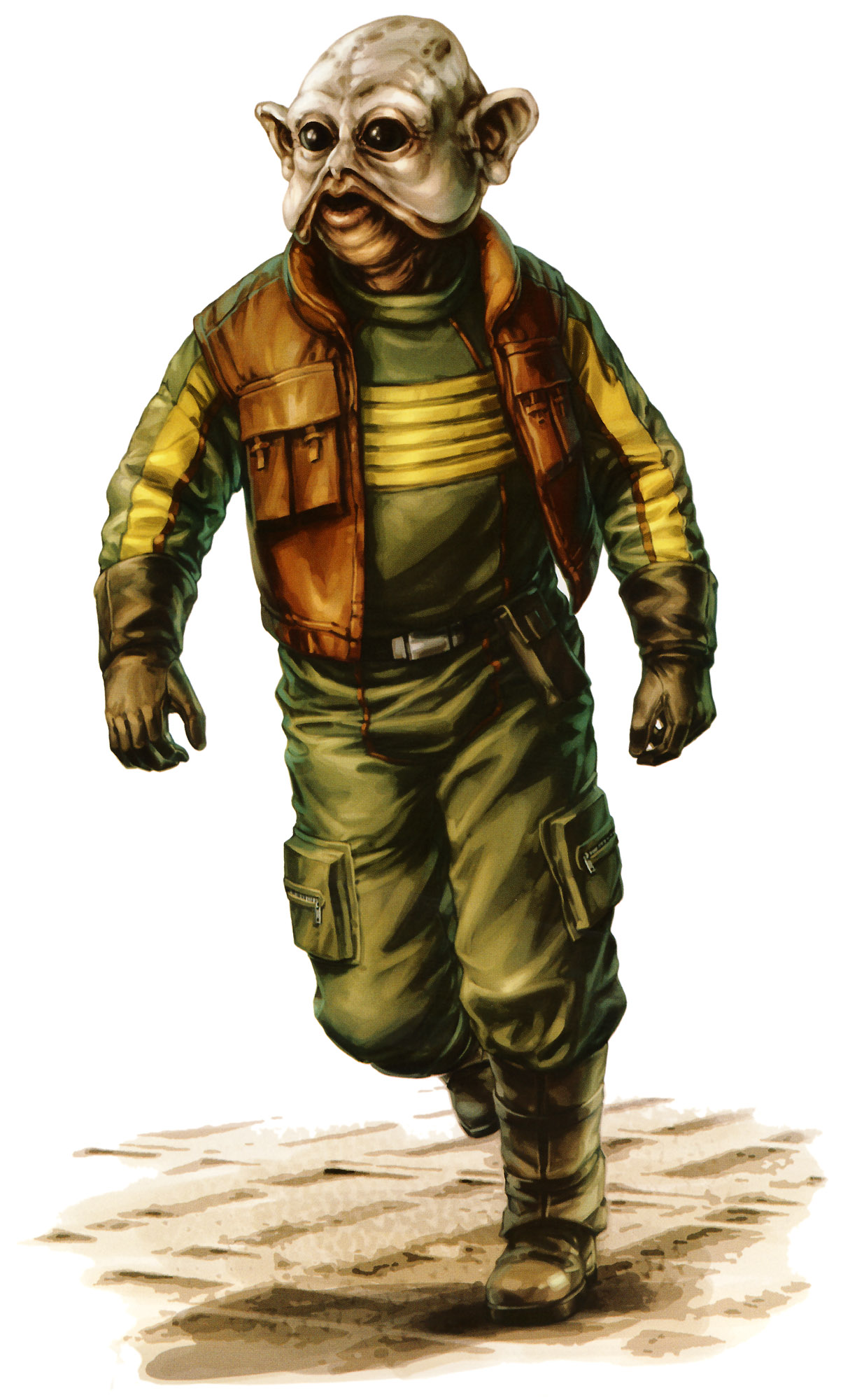
Sullustan
A diminutive species of near-Humans, Sullustans ranged from 1 to 1.8 meters in height and bore round, tapered skulls. Sullustans were distinguishable for their almond-shaped black eyes, facial jowls called dewflaps and large, round ears. Their wide earlobes provided excellent hearing, and their large eyes provided exceptional low-light vision and excellent peripheral vision. Sullustans could see up to 20 meters in the dark without being sensitive to infra-red, meaning they could effectively read and see normally with no light at all. Perhaps due to their relative lack of exposure to natural light, Sullustans began to suffer from corneal defects after 30 standard years. After significant deterioration, many chose to wear special visors to prevent further damage. Some Sullustans tattooed their heads as a form of individual expression.

Trandoshan
As a species, they were renowned across the galaxy for great strength. This is evidenced by several members of other species boasting physical prowess and power by having defeated a Trandoshan, either in battle or in a contest of strength.
- x2 human strength
- 1/2 human agility
- lost limbs regenerate in a week

Twi'lek
Twi'leks were an omnivorous humanoid species originating from the planet Ryloth. They tended to eat cultivated molds, fungi, and rycrit meat. Their distinctive features included colorful skin, which varied in pigment from individual to individual, and a pair of shapely prehensile tentacles that grew from the base of their skulls. The tentacles, called "brain-tails," "lekku," or "tchun-tchin," are advanced organs used for communication and cognitive functions. Twi'leks possessed a fairly standard humanoid vocal structure and were capable of learning most alien languages; however, they usually preferred their native language of Twi'leki, which incorporated subtle movement of the lekku. When they wish, they can even communicate in complete secrecy using their versatile brain-tails. Twi'lek females were often used as slaves or dancers because of their beauty.
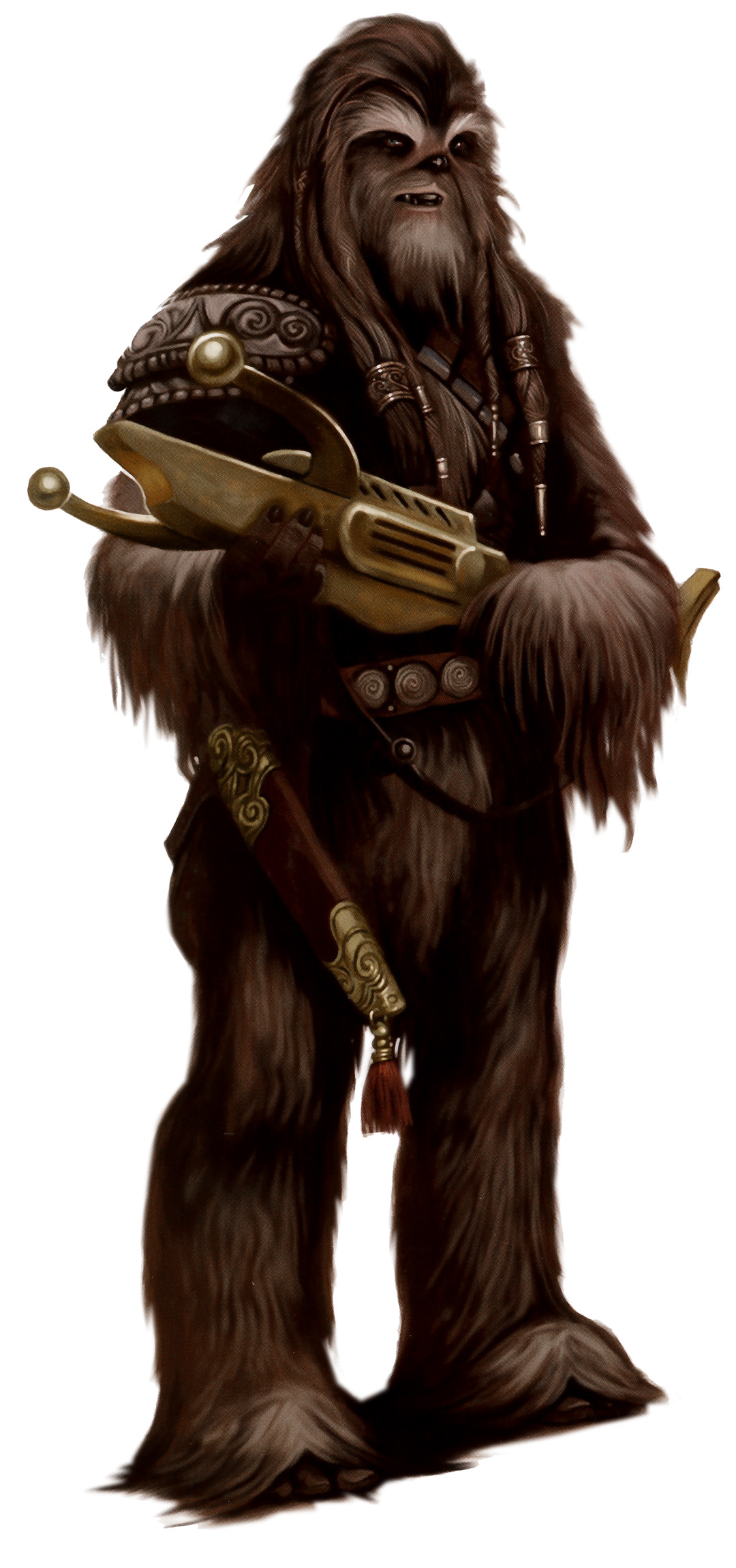
Wookiee
The Wookiees' natural habitat was the dense forests of the planet Kashyyyk (though one source does contend that they were immigrants to this planet). Kashyyyk was covered with massive wroshyr trees, in which the Wookiees constructed their homes and cities. Reportedly, Wookiees were descended from tree-climbing mammals. Adult Wookiees were tall, in excess of two meters in height, and were covered with a uniform, mid-length coat of thick hair in various shades of brown. Although albino Wookiees were rare, they were not unheard of. However, such a birth was generally held to be a bad omen, as white hair did not blend in with the earth-tones of their forest surroundings.
- 4x human strength
- can only speak Shyriiwook

Zabrak
Zabrak resembled Humans to some degree, but had a number of significant physical characteristics that set them apart from baseline Humanity. The most striking of these were a series of vestigial horns that crowned the heads of both males and females. These horns grew at puberty in varying patterns and signified that the time of their rite of passage was drawing near. The horns were one trait shared by the many Zabrak subspecies, which were divided by a number of physical characteristics that differed from subspecies to subspecies. These could include different skin tones (which included peachy white, yellow, red, tan, brown and black), horn patterns, hair growth (though it should be noted that Zabraks, unlike Humans, could not grow eyelashes or facial hair) and eye color (which have certain pigmentations that Humans lack, such as purple, yellow, red and orange). Another of the traits that made Zabrak instantly recognizable were their facial tattoos, which were made up of thin lines received during their rite of passage. These could symbolize many things, including but not limited to family lineage, place of birth, or even a design that reflected their individual personalities.
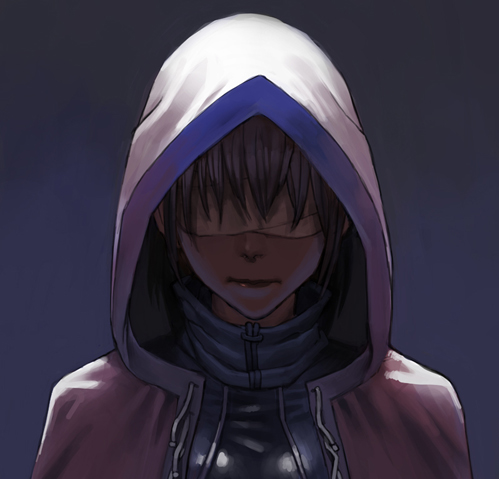
Mirakluka
They differed from Humans in that they lacked eyes, instead bearing only vestigial eye sockets, and perceived the environment around them through the Force instead of regular vision. This vision was so strong that if a Miralukan looked upon a Jedi or Sith they could "see" the Force radiation off them. The strength of a Miralukan's connection to the Force varied by individual.
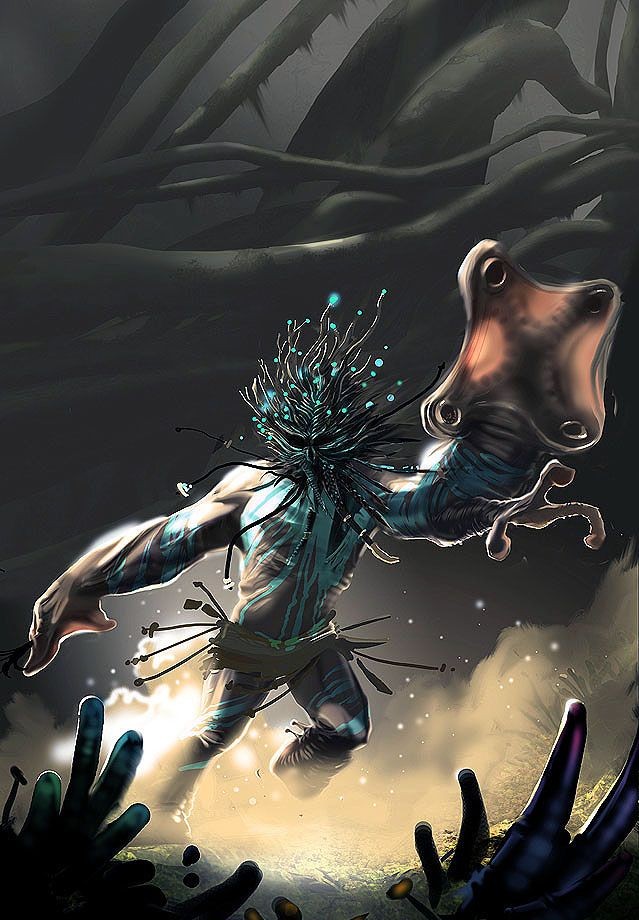
Felucian
Felucians were the native species of the fungi planet Felucia. The Felucians were sensitive to the Force as a species, but were driven deep into the jungles by the settlement of Gossam colonists on the world. The Felucians were tall, bipedal amphibious species and had natural camouflage that allowed them to seemingly disappear into their surroundings. They were equally at home on land or in water, and traveled the swamps with ease. Both their arms and legs ended in limbs with four cup-like, webbed fingertips. Their suction cup-like limbs enabled them to stick to surfaces. Springing from the underside of each arm was a second short arm, which ended in three large and agile fingers. their faces were constantly covered by masks.
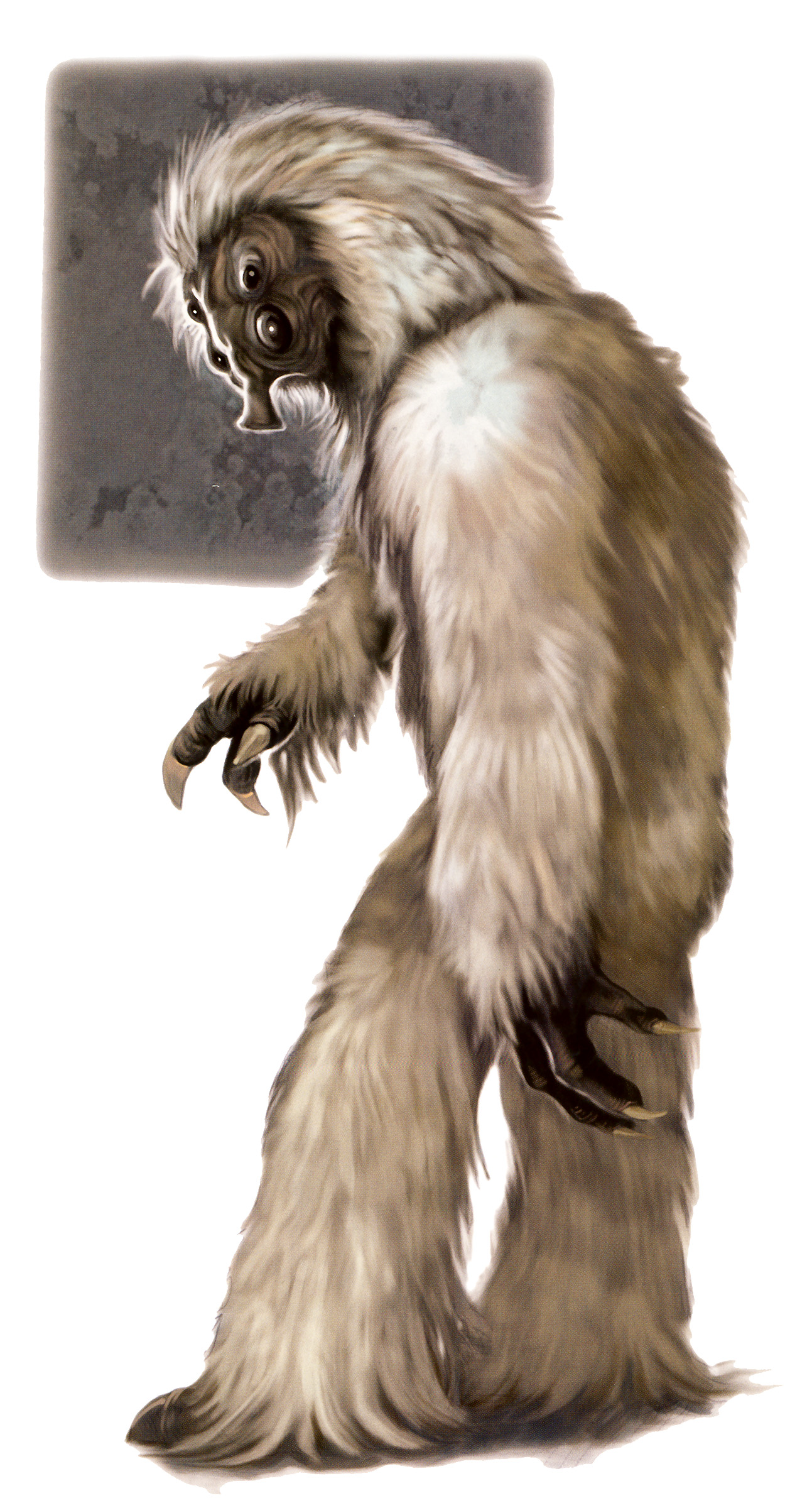
Talz
The Talz were a large furry race with two distinct sets of eyes: one for day vision, and one for night vision. Their homeworld was Alzoc III, a frozen world with much mineral wealth. They have also established a colony on the world of Orto Plutonia. Talz were rarely seen in the galaxy away from their homeworld. Talz were large, bipedal creatures, averaging 2 to 2.5 meters tall. Bulky creatures, they were covered head to toe in thick white fur, which provided exceptional insulation against their frozen world. Talz had four eyes, which were also adaptations to their native environment. The larger set of eyes were shut during the day, when sunlight reflected off the snow with dazzling brightness—able to blind sensitive optical organs, leaving the smaller set to navigate with. Alternatively, during the deep darkness of their homeworld's moonless night, the larger pair were utilized to provide the Talz with adequate vision.
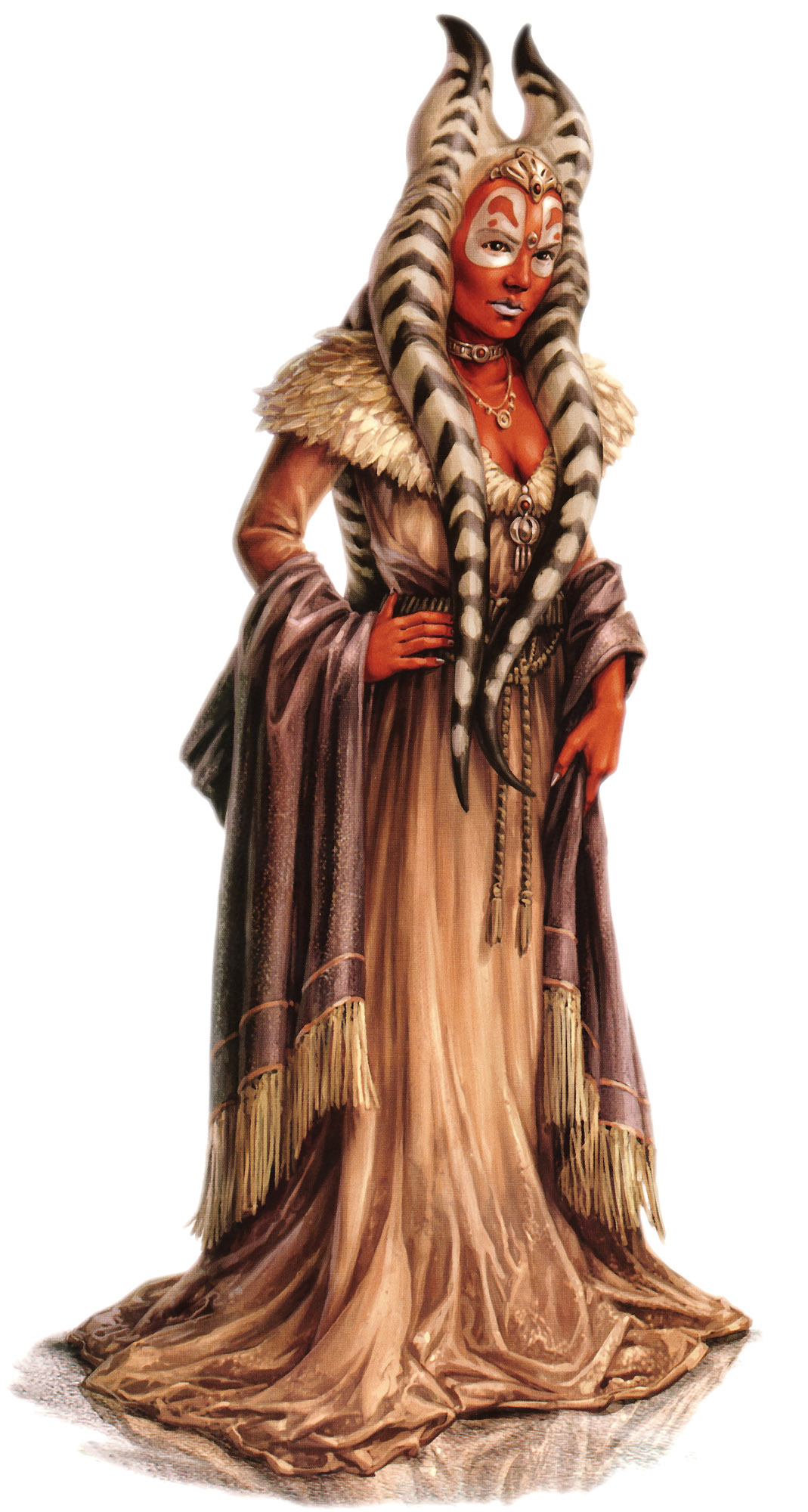
Togruta
The Togrutas were a humanoid species from the planet Shili. The race exhibited head-tails which were similar to those of Twi'leks, perhaps suggesting a common ancestry. Togrutas were also distinguished by montrals, large hollow horn-like projections from the top of their heads, that gave the species a form of passive echolocation. Togrutas had rusty skin tones ranging in hue from orange to red, with white pigmentation on their faces, and greyish lips. White stripes also adorned various parts of their bodies, including their chests, legs, backs, arms, lekku (head-tails), and montrals. The pattern of stripes varied from individual to individual. This red and white pattern was a phenotype left over from their ancestor's camouflage that helped them to blend in with their natural surroundings, especially the red-and-white turu-grass which dominated Shili's scrublands.
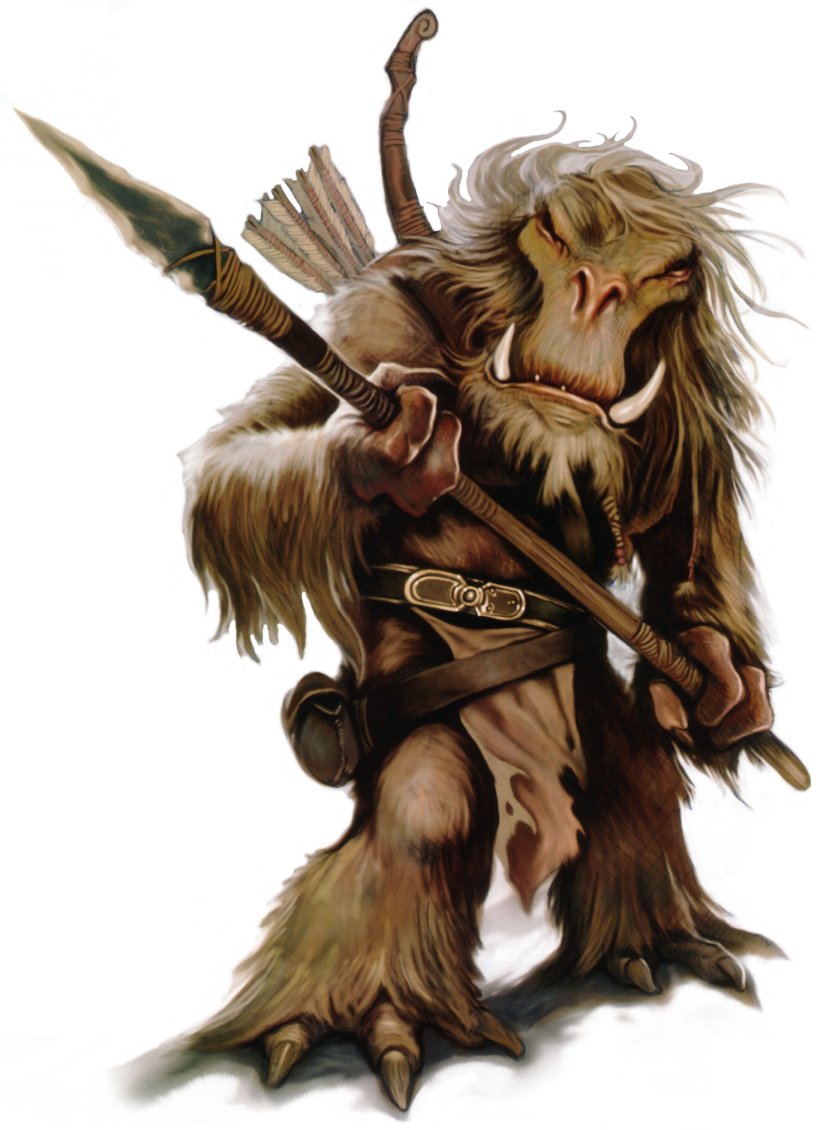
Whipid
Whiphids were tall, muscled, furred sentient beings from the planet Toola. They were notable for their great tusks. On Toola, Whiphids lived a primitive lifestyle, hunting caraboose and other large animals, such as the motmot, their favored prey. Their language consisted of approximately six thousand words. As Whiphids came into contact with more technically advanced races that came to Toola to buy ice, they began to show great curiosity about the rest of the galaxy. Many Whiphids left Toola, supporting themselves as big game hunters, mercenaries, or bounty hunters.
![]()
images2.wikia.nocookie.net/starwars/images/b/bd/Dug_NEGAS.jpg
[/img]
Human
Humans were the galaxy's most numerous and politically dominant sentient species with millions of major and minor colonies galaxywide. Believed to have originated on the galactic capital of Coruscant, they could be found anywhere, engaged in many different pursuits: spacers, mercenaries, smugglers, merchants, soldiers, assassins, farmers, crime lords, laborers, slaves, slavers, and many others, including Jedi. Since Humans were the most common sentient species, they were often considered to be a standard or average to which the biology, psychology, and culture of other species were compared.

Bothan
Bothans were furry mammalian anthropoids, about 1.5 meters tall. Hailing from Bothawui and several colonies, Bothans differed in facial appearance and body structure with canine, feline, and equine features. They were known for being master politicians and spies, craving intrigue and subterfuge
- poisons used against a Bothan last 2 extra rounds
- Bothans have access to the Bothan spynet (make a post on the Holonet with the tag (Spynet) asking a question an admin or another Bothan will give you what they know in exchange for you doing the same in the future)
- Bothans have access to the Bothan spynet (make a post on the Holonet with the tag (Spynet) asking a question an admin or another Bothan will give you what they know in exchange for you doing the same in the future)

Cerean
Cereans were a sophisticated and cultured humanoid mammalian species that hailed from the planet Cerea in the Mid Rim. They had tall tapering heads, which housed large binary brains, enabling them to focus on many things at the same time. Aside from this unique feature, Cereans were physically similar to Humans, although they possessed an extra heart, which supplied extra blood circulation to support their brains. Cerean males aged more quickly than the females, who had similar lifespans to Humans. Thus, there were fewer males than females. Polygamous marriage was a necessity in order for the species to survive. Each male usually had one primary "bond-wife", and between four and ten "honor-wives". Famous for their extraordinary thinking abilities, Cereans were often found among the ranks of the Jedi Knights, being exempt from the Jedi's vow of celibacy, due to their low birth rates. One such Jedi, Ki-Adi-Mundi, served the Jedi High Council during and prior to the outbreak of the Clone Wars.

Duros
The Duros, sometimes known as Durosians, were a humanoid species native to the planet Duro who were among the galaxy's first space faring races.Their homeworld was located on both the Corellian Trade Spine and at the end of the Duros Space Run, two major hyperspace routes that linked Duro with other important commercial centers. The Duros were humanoids with smooth blue-green skin, red eyes, lipless mouths, and long thin noseless faces. Olfactory glands beneath their eyes were responsible for their sense of smell. Both females and males were bald, though both genders were easily distinguished. Their large red goggle-like eyes also had slit pupils. Duros females gave birth to live young.

Ewok
Ewoks were sentient diminutive furry bipeds native to the forest moon of Endor. They were most notable for helping the Rebel Alliance defeat the forces of the Galactic Empire at the Battle of Endor, allowing the shield generator there to be destroyed, and in turn, the second Death Star. Ewoks were curious individuals that stood about one meter tall; they were omnivorous and used spears, slings, and knives as weapons; they also used hang gliders, battle wagons, and bordoks as vehicles. Although extremely skilled in forest survival and the construction of primitive technology like gliders and catapults, the Ewoks had yet to progress past stone-level technology when discovered by the Empire. They were quick learners, however, when exposed to advanced technology with simple mechanical processes and concepts. Some Ewoks were removed from their planet and taken as pets or slaves. Others left voluntarily out of a sense of curiosity, especially after the Battle of Endor led to the establishment of New Republic trading posts on the Forest Moon.
- 1/2 human strength due to size
- able to track those nearby with a heightened sense of smell
- only able to speak Ewokese and Basic
- able to track those nearby with a heightened sense of smell
- only able to speak Ewokese and Basic

Gamorrean
Gamorreans were typically green-skinned with a large powerful physique, and were known to be fierce warriors prized for their great strength and brutality in combat. They were organized into clans headed by a Council of Matrons. In Gamorrean society female sows perform all the productive work while the male boars concentrated on training for and fighting wars.
- Only able to speak Gamorrean and Basic
- 3x human strength
- 1/2 human agility
- 3x human strength
- 1/2 human agility

Gungan
The Gungans were humanoids native to the planet of Naboo. Prior to the Invasion of Naboo, the Gungans were a largely isolationist society. The Gungans were able to combine machinery with biology. Individuals were called a Gung.
- a gungan is able to hold its' breath for 6 rounds

Ithorian
Ithorians had two mouths and four throats, allowing them to speak in stereo. Female Ithorians had two humps on the back of their head, while males had only one. They had glossy, usually brown flesh. They stood roughly between 1.8 to 2.3 meters (5ft 10in. to 7ft 6in.) from eyestalk to toe. Their reflexes and coordination were somewhat slower than that of average humanoids.In addition to allowing them to speak their unique stereophonic language, the Ithorians' four throats had the ability to violently expel air, resulting in a deafening and concussive scream. Although even common Ithorians possessed this strange talent (which was possibly a leftover evolutionary defense mechanism), those with Force training (such as Jedi Master Roron Corobb) could push enough power into their sonic bellow to shatter iron and shred plasteel. Even so, many would go their entire lives without resorting to this physically taxing ability, and so its existence remained relatively ambiguous.
- +1 to Force Bellow

Mon Calamari
Mon Calamari were fish-like amphibious humanoids with domed heads, webbed hands, and large eyes. Male Mon Calamari had protrusions on their chin called "barbels" which grew more numerous with age. Most Mon Calamari had salmon-colored skin, often mottled with light and dark patterns, though examples of other skin colors were known. They could also descend to depths of up to 30 meters below sea level without breathing, though they found it uncomfortable and often used organic gills. Mon Calamari could stay underwater for a long period of time. Their hands, apart from being webbed, also featured five claw-tipped fingers; one opposable thumb with two more shorter claw-like protrusions, two long middle fingers, and two extremely short outer fingers. As an additional feature, Mon Calamari hands also presented three suction-cup like holes on their palms.Mon Calamari could swivel their eyes independently from one another, focusing on two areas at once. Mon Calamari saw in different wavelengths than Humans, making it difficult for one species to view visuals designed for the other and vice versa. Their eyes were often used to express emotion; staring with the left eye was a way of showing surprise, while staring with the right eye was either a challenge to fight or an expression of love, depending on the circumstances.
- can never drown
- 2x human swim speed
- can not see holograms meant for humans (they need special versions)

Rodian
The Rodians were green-skinned humanoids from the planet Rodia. They possessed distinctive faces; large, round, multifaceted eyes, tapir-like snouts, and a pair of saucer-shaped antennae on their heads. Rodian skin normally had a rough, pebbly texture, except on their hands and snouts. The flexible snouts augmented the Rodians finely-tuned olfactory senses, collecting and filtering the air. Their characteristically-large eyes were indicative of a primarily-nocturnal ancestry and were capable of seeing into the infra-red spectrum. This allowed the Rodians to visually detect the body heat of their hidden prey emanating from within the darkness.
- can see into the infrared spectrum and see heat signature (unaffected by darkness but obstacles still obstruct view)
- can not see holograms
- can not see holograms

Sullustan
A diminutive species of near-Humans, Sullustans ranged from 1 to 1.8 meters in height and bore round, tapered skulls. Sullustans were distinguishable for their almond-shaped black eyes, facial jowls called dewflaps and large, round ears. Their wide earlobes provided excellent hearing, and their large eyes provided exceptional low-light vision and excellent peripheral vision. Sullustans could see up to 20 meters in the dark without being sensitive to infra-red, meaning they could effectively read and see normally with no light at all. Perhaps due to their relative lack of exposure to natural light, Sullustans began to suffer from corneal defects after 30 standard years. After significant deterioration, many chose to wear special visors to prevent further damage. Some Sullustans tattooed their heads as a form of individual expression.
- can see up to 20 meters in the dark

Trandoshan
As a species, they were renowned across the galaxy for great strength. This is evidenced by several members of other species boasting physical prowess and power by having defeated a Trandoshan, either in battle or in a contest of strength.
- x2 human strength
- 1/2 human agility
- lost limbs regenerate in a week

Twi'lek
Twi'leks were an omnivorous humanoid species originating from the planet Ryloth. They tended to eat cultivated molds, fungi, and rycrit meat. Their distinctive features included colorful skin, which varied in pigment from individual to individual, and a pair of shapely prehensile tentacles that grew from the base of their skulls. The tentacles, called "brain-tails," "lekku," or "tchun-tchin," are advanced organs used for communication and cognitive functions. Twi'leks possessed a fairly standard humanoid vocal structure and were capable of learning most alien languages; however, they usually preferred their native language of Twi'leki, which incorporated subtle movement of the lekku. When they wish, they can even communicate in complete secrecy using their versatile brain-tails. Twi'lek females were often used as slaves or dancers because of their beauty.

Wookiee
The Wookiees' natural habitat was the dense forests of the planet Kashyyyk (though one source does contend that they were immigrants to this planet). Kashyyyk was covered with massive wroshyr trees, in which the Wookiees constructed their homes and cities. Reportedly, Wookiees were descended from tree-climbing mammals. Adult Wookiees were tall, in excess of two meters in height, and were covered with a uniform, mid-length coat of thick hair in various shades of brown. Although albino Wookiees were rare, they were not unheard of. However, such a birth was generally held to be a bad omen, as white hair did not blend in with the earth-tones of their forest surroundings.
- 4x human strength
- can only speak Shyriiwook

Zabrak
Zabrak resembled Humans to some degree, but had a number of significant physical characteristics that set them apart from baseline Humanity. The most striking of these were a series of vestigial horns that crowned the heads of both males and females. These horns grew at puberty in varying patterns and signified that the time of their rite of passage was drawing near. The horns were one trait shared by the many Zabrak subspecies, which were divided by a number of physical characteristics that differed from subspecies to subspecies. These could include different skin tones (which included peachy white, yellow, red, tan, brown and black), horn patterns, hair growth (though it should be noted that Zabraks, unlike Humans, could not grow eyelashes or facial hair) and eye color (which have certain pigmentations that Humans lack, such as purple, yellow, red and orange). Another of the traits that made Zabrak instantly recognizable were their facial tattoos, which were made up of thin lines received during their rite of passage. These could symbolize many things, including but not limited to family lineage, place of birth, or even a design that reflected their individual personalities.

Mirakluka
They differed from Humans in that they lacked eyes, instead bearing only vestigial eye sockets, and perceived the environment around them through the Force instead of regular vision. This vision was so strong that if a Miralukan looked upon a Jedi or Sith they could "see" the Force radiation off them. The strength of a Miralukan's connection to the Force varied by individual.
- +1 to Force Vision

Felucian
Felucians were the native species of the fungi planet Felucia. The Felucians were sensitive to the Force as a species, but were driven deep into the jungles by the settlement of Gossam colonists on the world. The Felucians were tall, bipedal amphibious species and had natural camouflage that allowed them to seemingly disappear into their surroundings. They were equally at home on land or in water, and traveled the swamps with ease. Both their arms and legs ended in limbs with four cup-like, webbed fingertips. Their suction cup-like limbs enabled them to stick to surfaces. Springing from the underside of each arm was a second short arm, which ended in three large and agile fingers. their faces were constantly covered by masks.
- Force Blast may either target an area or cause the target to be ravaged by poison until treated with Force Healing or by a medic

Talz
The Talz were a large furry race with two distinct sets of eyes: one for day vision, and one for night vision. Their homeworld was Alzoc III, a frozen world with much mineral wealth. They have also established a colony on the world of Orto Plutonia. Talz were rarely seen in the galaxy away from their homeworld. Talz were large, bipedal creatures, averaging 2 to 2.5 meters tall. Bulky creatures, they were covered head to toe in thick white fur, which provided exceptional insulation against their frozen world. Talz had four eyes, which were also adaptations to their native environment. The larger set of eyes were shut during the day, when sunlight reflected off the snow with dazzling brightness—able to blind sensitive optical organs, leaving the smaller set to navigate with. Alternatively, during the deep darkness of their homeworld's moonless night, the larger pair were utilized to provide the Talz with adequate vision.
- by closing or opening one or both sets of eyes, the Talz can effectively see in both extreme light or extreme darkness.
- may only speak Talzzi
- may only speak Talzzi

Togruta
The Togrutas were a humanoid species from the planet Shili. The race exhibited head-tails which were similar to those of Twi'leks, perhaps suggesting a common ancestry. Togrutas were also distinguished by montrals, large hollow horn-like projections from the top of their heads, that gave the species a form of passive echolocation. Togrutas had rusty skin tones ranging in hue from orange to red, with white pigmentation on their faces, and greyish lips. White stripes also adorned various parts of their bodies, including their chests, legs, backs, arms, lekku (head-tails), and montrals. The pattern of stripes varied from individual to individual. This red and white pattern was a phenotype left over from their ancestor's camouflage that helped them to blend in with their natural surroundings, especially the red-and-white turu-grass which dominated Shili's scrublands.
- can sense openants within 20 yards of them with a passive echolocation

Whipid
Whiphids were tall, muscled, furred sentient beings from the planet Toola. They were notable for their great tusks. On Toola, Whiphids lived a primitive lifestyle, hunting caraboose and other large animals, such as the motmot, their favored prey. Their language consisted of approximately six thousand words. As Whiphids came into contact with more technically advanced races that came to Toola to buy ice, they began to show great curiosity about the rest of the galaxy. Many Whiphids left Toola, supporting themselves as big game hunters, mercenaries, or bounty hunters.
- 4x human strength
- fur insulates against cold as low as -20 F
- 1/2 human agility due to their large cumbersome size
- can use their strong sense of smell to detect those nearby and track by scent
- fur insulates against cold as low as -20 F
- 1/2 human agility due to their large cumbersome size
- can use their strong sense of smell to detect those nearby and track by scent
images2.wikia.nocookie.net/starwars/images/b/bd/Dug_NEGAS.jpg
Dug
Dugs were an aggressive mammalian species native to the planet Malastare that used their upper limbs as legs and their lower limbs as arms. Dugs were slender, powerfully built beings with a somewhat humanoid build and a unique method of walking that hailed from the high gravity world Malastare. Their primary means of locomotion were their strong arms, and their lower limbs and feet were used for grappling and other fine motor manipulation. They hardly ever walked on their lower limbs. Dugs had smooth skin, which hung loosely around their tall necks, only to inflate during mating season calls. They also possessed fin-like ears and pronounced snouts. They lived mainly in the forests of the western continent of their homeworld in primitive tree villages called "tree thorps". On their homeworld Malastare, the Dugs were arboreal beings. They brachiated among the canopies with alarming speed using all four limbs.

Kaminoan
Kaminoans were a tall, thin species with pale skin from the isolated watery planet of Kamino. The Kaminoans lived in large stilted cities that rose above the ocean surface, such as Tipoca City. The species' evolution from aquatic creatures in the vast oceans of Kamino was reflected in their tall shape, glassy coated eyes, near luminescent skin, and long, thin necks. There were many peculiarities about the particulars of Kaminoan physiology: digitigrade and slender legs, once adapted for firm seabeds, eventually only saw use in the hallways of their science facilities, while only male Kaminoans exhibited fin ridges along the rear of their small, bulbous skulls. The almond-shaped eyes of Kaminoans were also able to see color in the ultraviolet spectrum. Therefore, what appeared as white dwellings were actually colored with shades that Humans and a number of other species couldn't see.
[/center]
